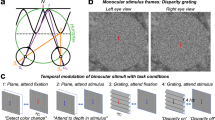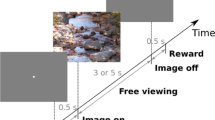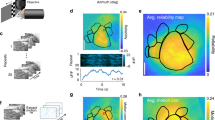Abstract
Stereopsis is the perception of depth based on small positional differences between images formed on the two retinae (known as binocular disparity). Neurons that respond selectively to binocular disparity were first described three decades ago1,2, and have since been observed in many visual areas of the primate brain, including V1, V2, V3, MT and MST3,4,5,6,7,8. Although disparity-selective neurons are thought to form the neural substrate for stereopsis, the mere existence of disparity-selective neurons does not guarantee that they contribute to stereoscopic depth perception. Some disparity-selective neurons may play other roles, such as guiding vergence eye movements9,10. Thus, the roles of different visual areas in stereopsis remain poorly defined. Here we show that visual area MT is important in stereoscopic vision: electrical stimulation of clusters of disparity-selective MT neurons can bias perceptual judgements of depth, and the bias is predictable from the disparity preference of neurons at the stimulation site. These results show that behaviourally relevant signals concerning stereoscopic depth are present in MT.
This is a preview of subscription content, access via your institution
Access options
Subscribe to this journal
Receive 51 print issues and online access
$199.00 per year
only $3.90 per issue
Buy this article
- Purchase on Springer Link
- Instant access to full article PDF
Prices may be subject to local taxes which are calculated during checkout




Similar content being viewed by others
References
Barlow, H. B., Blakemore, C. & Pettigrew, J. D. The neural mechanism of binocular depth discrimination. J. Physiol. (Lond.) 193, 327–342 (1967).
Pettigrew, J. D., Nikara, T. & Bishop, P. O. Binocular interaction on single units in cat striate cortex: simultaneous stimulation by single moving slit with receptive fields in correspondence. Exp. Brain Res. 6, 391–410 (1968).
Hubel, D. H. & Wiesel, T. N. Stereoscopic vision in macaque monkey. Cells sensitive to binocular depth in area 18 of the macaque monkey cortex. Nature 225, 41–42 (1970).
Poggio, G. F. & Fischer, B. Binocular interaction and depth sensitivity in striate and prestriate cortex of behaving rhesus monkey. J. Neurophysiol. 40, 1392–1405 (1977).
Poggio, G. F., Gonzalez, F. & Krause, F. Stereoscopic mechanisms in monkey visual cortex: binocular correlation and disparity selectivity. J. Neurosci. 8, 4531–4550 (1988).
Felleman, D. J. & Van Essen, D. C. Receptive field properties of neurons in area V3 of macaque monkey extrastriate cortex. J. Neurophysiol. 57, 889–920 (1987).
Maunsell, J. H. & Van Essen, D. C. Functional properties of neurons in middle temporal visual area of the macaque monkey. II. Binocular interactions and sensitivity to binocular disparity. J. Neurophysiol. 49, 1148–1167 (1983).
Roy, J. P., Komatsu, H. & Wurtz, R. H. Disparity sensitivity of neurons in monkey extrastriate area MST. J. Neurosci. 12, 2478–2492 (1992).
Cumming, B. G. & Parker, A. J. Responses of primary visual cortical neurons to binocular disparity without depth perception. Nature 389, 280–283 (1997).
Masson, G. S., Busettini, C. & Miles, F. A. Vergence eye movements in response to binocular disparity without depth perception. Nature 389, 283–286 (1997).
Albright, T. D. Cortical processing of visual motion. Rev. Oculomotor Res. 5, 177–201 (1993).
Albright, T. D., Desimone, R. & Gross, C. G. Columnar organization of directionally selective cells in visual area MT of the macaque. J. Neurophysiol. 51, 16–31 (1984).
Salzman, C. D., Murasugi, C. M., Britten, K. H. & Newsome, W. T. Microstimulation in visual area MT: effects on direction discrimination performance. J. Neurosci. 12, 2331–2355 (1992).
Salzman, C. D. & Newsome, W. T. Neural mechanisms for forming a perceptual decision. Science 264, 231–237 (1994).
DeAngelis, G. C., Groh, J. M. & Newsome, W. T. Organization of disparity selectivity in macaque area MT. Soc. Neurosci. Abstr. 22, 717 (1996).
Cox, D. R. & Snell, E. J. Analysis of Binary Data (Chapman and Hall, London, (1989)).
Bradley, D. C., Chang, G. C. & Andersen, R. A. Encoding of three-dimensional structure-from-motion by primate area MT neurons. Nature 392, 714–717 (1998).
Dodd, J. V., Cumming, B. G., Newsome, W. T. & Parker, A. J. Firing of V5 (MT) neurons reliably covaries with reported 3-D configuration in a perceptually-ambiguous structure-from-motion task. Soc. Neurosci. Abstr. 23, 1125 (1997).
Schiller, P. H. The effects of V4 and middle temporal (MT) area lesions on visual performance in the rhesus monkey. Vis. Neurosci. 10, 717–746 (1993).
Britten, K. H., Shadlen, M. N., Newsome, W. T. & Movshon, J. A. The analysis of visual motion: a comparison of neuronal and psychophysical performance. J. Neurosci. 12, 4745–4765 (1992).
Robinson, D. A. Amethod of measuring eye movement using a scleral search coil in a magnetic field. IEEE Trans. Biomed. Eng. 10, 137–145 (1963).
Judge, S. J., Richmond, B. J. & Chu, F. C. Implantation of magnetic search coils for measurement of eye position: an improved method. Vision Res. 20, 535–538 (1980).
Murasugi, C. M., Salzman, C. D. & Newsome, W. T. Microstimulation in visual area MT: effects of varying pulse amplitude and frequency. J. Neurosci. 13, 1719–1729 (1993).
Acknowledgements
We thank J. Stein and C. Doane for technical assistance, and A. Parker, J. Dodd, B.Wandell, J. Nichols, E. Siedemann, G. Horwitz, and C. Barberini for critical review of the manuscript. G.C.D. was supported by a Medical Research Fellowship from the Bank of America/Giannini Foundation, an NRSA from the National Eye Institute, and a Career Award in the Biomedical Sciences from the Burroughs-Wellcome Fund. B.G.C. is a Royal Society Research Fellow, and W.T.N. is an Investigator of the Howard Hughes Medical Institute. This work was also supported by the National Eye Institute.
Author information
Authors and Affiliations
Corresponding author
Rights and permissions
About this article
Cite this article
DeAngelis, G., Cumming, B. & Newsome, W. Cortical area MT and the perception of stereoscopic depth. Nature 394, 677–680 (1998). https://doi.org/10.1038/29299
Received:
Accepted:
Issue Date:
DOI: https://doi.org/10.1038/29299
This article is cited by
-
Visual timing-tuned responses in human association cortices and response dynamics in early visual cortex
Nature Communications (2022)
-
A neural correlate of perceptual segmentation in macaque middle temporal cortical area
Nature Communications (2022)
-
Scene-relative object motion biases depth percepts
Scientific Reports (2022)
-
Neurophysiological considerations for visual implants
Brain Structure and Function (2022)
-
Effects of stereopsis on vection, presence and cybersickness in head-mounted display (HMD) virtual reality
Scientific Reports (2021)
Comments
By submitting a comment you agree to abide by our Terms and Community Guidelines. If you find something abusive or that does not comply with our terms or guidelines please flag it as inappropriate.



